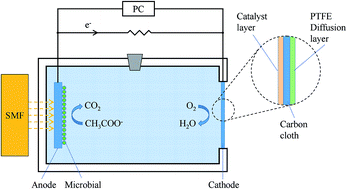Effect of static magnetic field on the performances of and anode biofilms in microbial fuel cells†
Abstract
The electricity production and substrate removal rate of microbial fuel cells (MFCs) could be improved by the application of a static magnetic field (SMF). The effects of SMF intensities on cell performances and the activity of anode biofilms were investigated in this manuscript. A MFC with an intensity of 220 mT SMF obtained the best cell performances. The maximum output voltage increased from 360.1 mV to 756.1 mV and the coulombic efficiencies increased from 34.57% to 60.46% compared with the control. And the start-up time decreased from 200 h (the control) to 140 h in MFC-220. Ammonia in MFCs was removed by volatilization of ammonia, nitrification and denitrification in MFC. And nitrogen compounds in MFCs were nitrified thoroughly with SMF. With a low SMF (≤220 mT), a MFC could enhance the Coulomb efficiency by inhibiting methane production. SMF promotes power outputs by affecting the enzyme activity and bioelectrochemical activity of biofilms as well as biomass. With increased low SMF intensity, the microorganism was stimulated to produce more extracellular polymeric substance. Scanning electron microscope and confocal laser scanning microscopy images showed that bacteria and biopolymers coexisted or overlapped on the anode. However, a high intensity (≥360 mT) of the applied SMF was harmful to microbial growth and had negative effects on cell performance.


 Please wait while we load your content...
Please wait while we load your content...